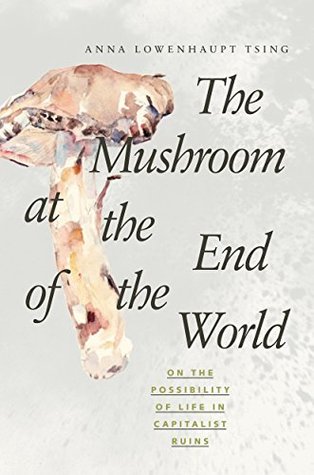More on this book
Community
Kindle Notes & Highlights
mosaic of open-ended assemblages of entangled ways of life, with each further opening into a mosaic of tem...
This highlight has been truncated due to consecutive passage length restrictions.
Yet theories of heterogeneity are still in their infancy.
we need to reopen our imaginations.
Contemporary commerce works within the constraints and possibilities of capitalism.
This book shows how it is possible to study capitalism without this crippling assumption—by combining close attention to the world, in all its precarity, with questions about how wealth is amassed. How might capitalism look without assuming progress? It might look patchy: the concentration of wealth is possible because value produced in unplanned patches is appropriated for capital.
New developments in ecology make it possible to think quite differently by introducing cross-species
interactions and disturbance histories.
I look for disturbance-based ecologies in which many species sometimes live together without ...
This highlight has been truncated due to consecutive passage length restrictions.
the history of the human concentration of wealth through making both humans and nonhumans into resources for investment.
This history has inspired investors to imbue both people and things with alienation, that is, the ability to stand alone, as if the entanglements of living did not matter.
Through alienation, people and things become mobile assets; they can be removed from their life worlds in distance-defying transport to be exchanged with oth...
This highlight has been truncated due to consecutive passage length restrictions.
Alienation obviates living-space entanglement.
Global landscapes today are strewn with this kind of
ruin.
Our first step is to bring back curiosity.
But living seems to have gotten more crowded, not only with Japanese aesthetics and eco logical histories, but also with international relations and capitalist trading practices.
The broken forest, in contrast, seemed like a science fiction nightmare.
This book is my attempt to pull you into the maze I found.
It seems that the utopian imagination
trapped, like capitalism and industrialism and the human population, in a one-way future consisting only of growth.
The 1986 Chernobyl disaster had contaminated Europe’s mushrooms, and traders had come to the Pacific Northwest for supplies.
This was in the middle of a “jobs versus the environment” battle over the forests, yet neither side noticed the mushroomers.
the foragers—disabled white veterans, Asian refugees, Native Americans, and undocumented Latinos—were invisible interlopers.
A few years into the new century, the idea of a trade-off between jobs and the environment seemed less convincing.
We are stuck with the problem of living despite economic and ecological ruination.
Not that this will save us—but it might open our imaginations.
Geologists have begun to call our time the Anthropocene, the epoch in which human disturbance outranks other geological forces.
Thus, although some interpreters see the name as implying the triumph of humans, the opposite seems more accurate: without planning or intention, humans have made a mess of our planet.
The concept of the Anthropocene both evokes this bundle of aspirations, which one might call the modern human conceit, and raises the hope that we might muddle beyond
What brings Mien and matsutake together in Oregon? Such seemingly trivial queries might turn everything around to put unpredictable encounters at the center of things.
But most of the time we imagine such precarity to be an exception to how the world works. It’s what “drops out” from the system.
What if, as I’m suggesting, precarity is the condition of our time—or, to put it another way, what if our time is ripe for sensing precarity?
What if precarity, indeterminacy, and what we imagine as trivial are the center of t...
This highlight has been truncated due to consecutive passage length restrictions.
Precarity is the condition of being vulner...
This highlight has been truncated due to consecutive passage length restrictions.
Unable to rely on a stable structure of community, we are thrown into shifting assemblages, which rem...
This highlight has been truncated due to consecutive passage length restrictions.
Thinking through precarity changes social analysis. A precarious world is a w...
This highlight has been truncated due to consecutive passage length restrictions.
The only reason all this sounds odd is that most of us were raised on dreams of modernization and progress.
Progress is embedded, too, in widely accepted assumptions about what it means to be human.
As long as we imagine that humans are made through progress, nonhumans are stuck within this imaginative framework too.
Progress is a forward march, drawing other kinds of time into its rhythms. Without that driving beat, we might notice other temporal patterns.
The curiosity I advocate follows such multiple temporalities, revitalizing description and imagination.
Yet the modern human conceit is not the only plan for making worlds: we are surrounded by many world-making projects, human and not human.
Making worlds is not limited to humans.
in fact, all organisms make ecological living places, altering earth, air, and water.
As these examples suggest, world-making projects can overlap, allowing room for more than one species. Humans, too, have always been involved in multispecies world making.
Twentieth-century scholarship, advancing the modern human conceit, conspired against our ability to notice the divergent, layered, and conjoined projects that make up worlds. Entranced by the expansion of certain ways of life over others, scholars ignored questions of what else was going on. As progress tales lose traction, however, it becomes possible to look differently.
The concept of assemblage is helpful. Ecologists turned to assemblages to get around the sometimes fixed and bounded connotations of ecological “community.”
As semblages are open-ended gatherings.
If history without progress is indeterminate and multidirectional, might assemblages show us its possibilities?
Surprisingly, this turns out to be a method that might revitalize political economy as well as environmental studies.


